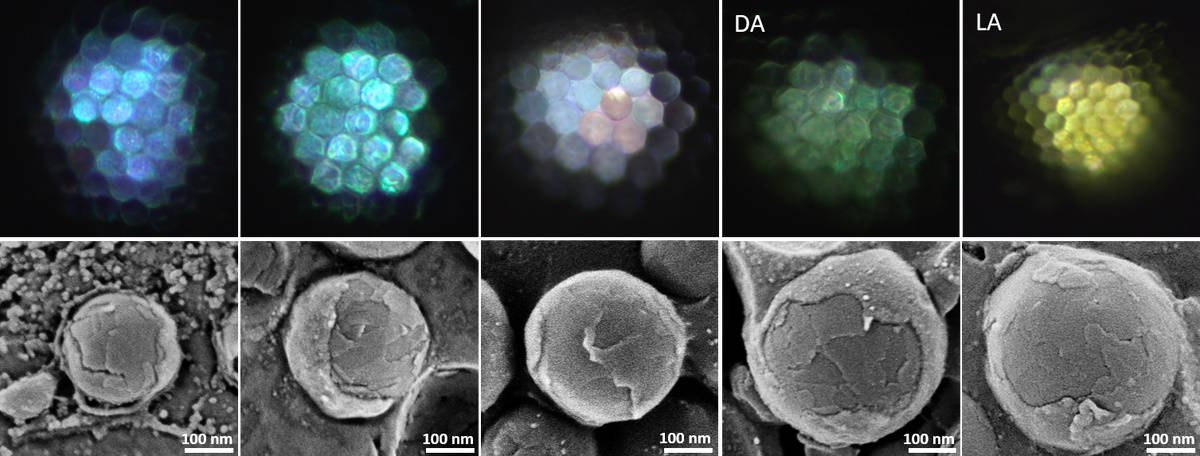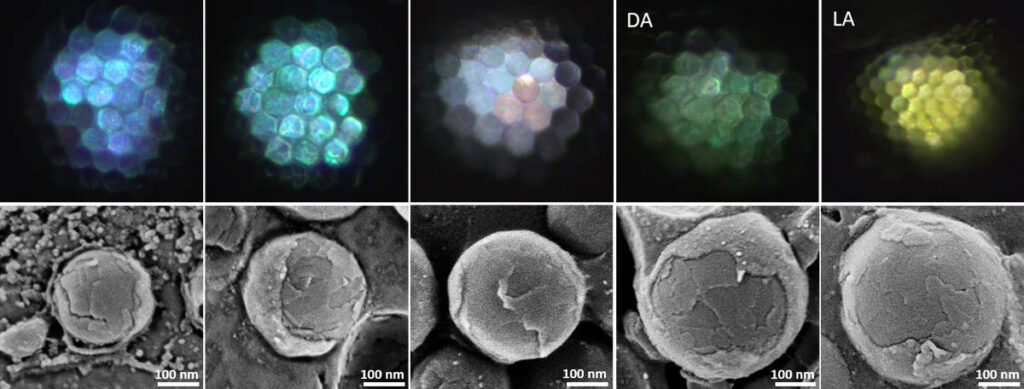Researchers have discovered a nanomaterial-based reflector that overlies the eye pigments in certain baby crustaceans. The pigments, which are made from tiny crystalline spheres of isoxanthopterin, allow the animals to become completely transparent and so hide from predators. The structures could inspire the development of biocompatible artificial photonic materials.
Many creatures that live in the ocean appear transparent to avoid ending up as prey, but their eyes can give them away because they contain opaque pigments. To better camouflage their eyes, many crustaceans have developed reflectors that cover their dark eye pigments, producing an “eyeshine” that reflects light at wavelengths matching those of the water they live in, that is, the wavelengths of visible light (400 to 750 nm).
In their new work, detailed in Science, researchers led by Johannes Haataja of the University of Cambridge in the UK and Benjamin Palmer from Ben Gurion University in Israel, used optical and cryogenic scanning electron microscopy to study several species of shrimp and prawns, including the freshwater species Machrobrachium rosenbergi.
They found that the eyeshine is produced by highly reflective cells made from a photonic glass containing crystalline isoxanthopterin nanospheres on the interior of the crustaceans’ eyes. The eyeshine colour ranges from deep blue to green/yellow depending on the size of the nanospheres and how they are ordered. This modulation helps the creatures “blend in” with different background colours, which vary depending on the time of day and the depth that they find themselves in, explains Palmer.
A nice surprise
As sometimes happens in science, the researchers made their discovery quite by chance – as they were initially studying how isoxanthopterin crystals form in certain species of shrimp as they develop. Indeed, in previous work, they had found that that adult decapod crustaceans used a back-scattering reflector (tapetum) lying behind the retina made from these crystals to increase the amount of light they capture.
“We had a nice surprise, however, in that we found that larval shrimp also use crystalline reflectors – albeit for a very different optical purpose to the adults,” explains Palmer. “Our work is based on a previous study by another group who found this effect in larval stomatopod crustaceans. We also found that the eyeshine phenomenon is present in other larval decapod crustaceans with differently coloured eyes.”
Invisible against the background
To discover the material responsible for this reflectance, the team used cryogenic-scanning electron microscopy – a technique that allows biological tissue to be imaged in a close-to-life state without introducing artefacts resulting from the dehydration of wet biological tissue. The images obtained showed that the reflector was made of spheres. Upon closer examination, using transmission electron tomography and electron diffraction, the researchers found that the spheres were made from isoxanthopterin crystals, just like in adult crustacean eyes.
“However, in the larval case, the anatomical position and optical function of the spheres is very different,” Palmer tells Physics World. “The reflector sits atop the absorbing pigments in the eye and reflects light away from the conspicuous eye pigments to render the animals invisible against the background.”

The key to the camouflage, he says, is the animal’s ability to control the size of the spheres, which, as mentioned, determines the colour of the reflector. A critical part of the study, he adds, was the computational work performed by Haataja and Lukas Schertel. “Their three-dimensional models allowed us to test the effect of numerous structural parameters on the optical properties of the reflector, including particle size, particle filling fraction, cell size, particle birefringence and particle hollowness,” explains Palmer.
Organic biomineralization
The researchers say that they would now like to better understand how different organisms use crystalline materials to manipulate light for different functions. This field, known as organic biomineralization, is garnering ever more attention in the community, Palmer explains. A key question here is to understand how organisms control the crystallization of these materials, with the aim of developing new ways to synthesize artificial equivalents for use in real-world applications.
“Whilst we are more concerned with the fundamental science, it is very possible that there could be bio-inspired materials generated from this study,” he says. “Isoxanthopterin nanospheres have an incredibly high refractive index (around 2.0 in certain crystallographic directions), which makes them extremely efficient at reflecting light. And the fact that the colour for the reflected light can be tuned by controlling the sphere size makes them, in principle, very versatile optical materials.”
There is currently a lot of interest, Palmer adds, in replacing conventional inorganic scattering materials (used in food additives, paints and cosmetics, for example) with organic analogues. “The material described in this work would be an excellent candidate but there are many fundamental things we need to learn first.”


